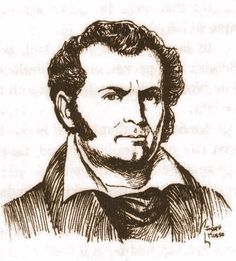| The James Bowie Sandbar Fight |
| The Bowie knife gained notoriety after a particular incident on a Mississippi River sandbar in 1827, involving James Bowie and several other combatants. The historical marker near the location, in Adams County, MS, reads: James Bowie Sandbar Fight This incident occurred on September 19, 1827, on a sand beach on the eastern shore of the Mississippi. Begun as a formal duel, it soon devolved into a Wild West gun and knife fight. James Bowie, one of 13 men from Louisiana, though severely wounded and armed only with a knife, killed one opponent, wounded another and became a legend almost overnight. Jim Bowie was born in Kentucky in 1796, the son of Reason or Rezin and Elve Ap-Catsby Jones Bowie. In 1801, Reason moved his family to Louisiana and settled in what is now Catahoula Parish. Several years later, they moved to southeastern Louisiana, near Opelousas. The family owned a plantation, raising sugar cane and cotton, and bought and sold slaves. Later, after the War of 1812, James and brother, Rezin Bowie, bought slaves from the pirate, Jean Laffite, who ran a slave market on Galveston Island. Laffite landed slaves at Bowie's Island on Vermillion Bay and the Bowie's sold the slaves in St. Landry Parish. It was illegal to bring slaves into the country at this time. James was quick-tempered and made his share of enemies in Louisiana. After an encounter with Rapides Sheriff Norris Wright, in Alexandria, in 1826, when Wright fired at Bowie, Rezin gave James a large, butcher-like hunting knife to carry. Neither of them could have imagined what was in store for James.....or the knife. In 1827, Samuel Levi Wells and Dr. Thomas Maddox participated in a duel on a large sandbar above Natchez, on the Mississippi state side of the river. Upon firing, neither man hit the other and they proceeded to shake hands and start to leave the site. But some people in Maddox's group suddenly fired at the Wells' group, which included James Bowie. Bowie was shot through the lung. Long-time enemy, Norris Wright, then began stabbing him with swordcanes repeatedly. With a summoning of all of the strength he had left, Bowie grabbed Wright and sank the large knife he was carrying into Wright's heart, instantly killing him. Witnesses described the "large butcher knife" to other people, newspapers printed stories of the event, and a legend was born. Already riding a crest of popularity from the Natchez incident, in 1830, the knife gained even more prominence, after another famous fight by its owner. Jim Bowie was attacked by three men who had been hired to kill him. Bowie came out the victor and the end of the fight found one of the attackers almost beheaded, another disemboweled and the third with his skull split open. As the Red River Herald newspaper, of Natchitoches, Louisiana, stated, "All the steel in the country, it seemed, was immediately converted into Bowie knives." Faithful to his weapon of choice until the end, Jim Bowie had his knife with him at the Alamo. When the Alamo was overrun by the enemy, Bowie was very ill and lay on a cot in the barracks with his Bowie knife and a pistol in his hands. Legend has it that he killed nine Mexican soldiers before his life came to an end. We may never know if that legend is true, but we do know that the famous sandbar fight near Natchez was the beginning of Bowie's fame and the Bowie Knife's popularity. It remained in public favor until after the Civil War, when the Colt revolver, more dependable than guns before it, gained the public's confidence and replaced the Bowie knife as the "every man's" trusty weapon. ~~~~~~~~~ Mississippi Outlaws Index Whispers - Home |
